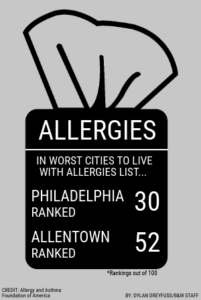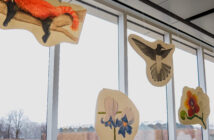 Coming back to Lehigh in the August means new beginnings: new classes, new supplies, catching up with friends and the familiar case of seasonal allergies.
Coming back to Lehigh in the August means new beginnings: new classes, new supplies, catching up with friends and the familiar case of seasonal allergies.
The sneezing, itchy eyes and stuffy nose that some Lehigh students know all too well appear almost instantly.
Perhaps it was dust in rooms that hasn’t been cleaned since May, or the mold that has taken over your dorm, apartment or home.
While those are all likely possibilities, the reason behind some students’ allergies is actually the Lehigh Valley itself.
“Allergies are particularly bad in the Lehigh Valley,” said Eric Schenkel, a doctor at the Allergy Partners of the Lehigh Valley. “It’s rural and the surrounding mountains seem to trap pollen inside.”
Allentown has regularly made the Allergy and Asthma Foundation of America’s list of worst cities to live with allergies. In the 2018 spring report, Allentown was ranked 52 out of 100.
Lehigh’s campus, situated deep inside the valley, is the perfect target for seasonal allergies like ragweed, pollen and dust.
In the fall and spring, when trees and plants surrounding campus are shedding or blooming, Schenkel said students might find themselves with allergies they might not even know they had.
According to the American College of Allergy, Asthma and Immunology, tree, grass and weed pollination is beginning earlier in the year and lasts much longer than it has in the past due to climate change factors, such as an increase in carbon dioxide and humidity.
Kelsey Smith, ’21, has both fall and spring pollen allergies, and said her symptoms are worse when she is at the Lehigh rather than home.
“I am allergic to pollen and get a runny nose, itchy eyes and I’m constantly sneezing,” Smith said.
Typical allergy symptoms include sneezing, nasal congestion and runny and itchy nose and eyes. More extreme symptoms include chest tightness and wheezing, which can be worse for someone with asthma.
Schenkel said pollen counts are significantly higher in the Lehigh Valley than that of the surrounding areas like Philadelphia and northern New Jersey.
“Nearby areas like Philadelphia and Pittsburgh are rated numbers 30 and 33, respectively, out of 100 worst places to live with allergies,” said Angel Waldron of the Allergy and Asthma Foundation of America.
Waldron said the best way someone can handle allergies is to first identify what he or she is allergic to, and then get in contact with an allergy specialist.
Schenkel said the easiest way to treat allergies is through allergen immunotherapy, also known as allergy shots. Over-the-counter medication can help many suffering with allergies, but he said allergy shots provide the most relief.
Avoidance measures can be taken to mitigate allergy symptoms such as using air conditioning, HEPA air purifiers and dehumidifiers.
Waldron said those suffering from allergies should remain inside between 10 a.m. and 2 p.m., and if they must go out, they should remove their shoes and clothing immediately upon arriving at home to avoid bringing allergens inside.
The Fall 2018 Worst Places to Live with Allergies list will be released on Sept. 25 by the Allergy and Asthma Foundation of America.





Comment policy
Comments posted to The Brown and White website are reviewed by a moderator before being approved. Incendiary speech or harassing language, including comments targeted at individuals, may be deemed unacceptable and not published. Spam and other soliciting will also be declined.
The Brown and White also reserves the right to not publish entirely anonymous comments.